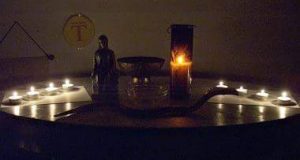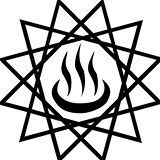by Melissa edited by various authors
(20-26 Anthesterion) Although originally the Lesser Mysteries had an independent existence, once Athens annexed Eleusis these rites were coupled with the Great Mysteries: candidates for initiation at the latter were required first to undergo initiation at the former.
As at the Greater Mysteries (see Eleusianian Mysteries), initiates kept what happened there secret so our sources for information about them are limited. It is likely, however, that they occurred near the Ilissos River, which was used for ablutions. The Lesser Mysteries themselves took place at a shrine located near this river. Moreover, legend connected Heracles to these mysteries, explaining that he was unable to take part in the Eleusinian mysteries because he was a “foreigner”, so the Lesser Mysteries were instituted on his behalf. Even so, he first had to undergo purification from blood guilt, and carvings show Heracles doing just that, in company with Demeter, Persephone and the Eleusinian torch bearer (who although male, represents torch-bearing Hekate, as in the Homeric Hymn 2, line 52)—suggesting that purification took place as part of these mysteries (Parke 123).
Whether purification was merely a preliminary or was the main feature of these Mysteries is unclear, but many cultures undergo rituals of purification in the spring, coinciding with the earliest growth of plants. In the Hymn, Hades abducts Persephone during the spring while she is “gathering flowers over a soft meadow, roses and crocuses and beautiful violets, irises also and hyacinths and the narcissus” (lines 6-8). However Demeter tells her, “when the earth shall bloom with the fragrant flowers of spring in every kind, then from the realm of darkness and gloom thou shalt come up once more to be a wonder for Gods and mortal men” (lines 401-403, White translation). We also know that when Persephone returned to her mother the first time, after a long period of mourning by both Goddesses, Demeter “straightway made fruit to spring up from the rich lands, so that the whole wide earth was laden with leaves and flowers” (lines 471-473).

In addition to purification, the Lesser Mysteries included dramatic representations of the legend of the two Goddesses (Parke 123), which would serve to remind people of the connection of the season with the harvest cycle. Helene P. Foley, in her background article on the Eleusinian Mysteries in her edition of The Homeric Hymn to Demeter, states that “all important rites of Demeter in Attica seem to have been linked (at least loosely) to stages of the agricultural year (p 71). Moreover, these festivals seem to have a connection with some part of the Homeric Hymn, especially since Eleusis, which was incorporated into Attica, was the site of much of the narrative of the Hymn. Thus The Lesser Mysteries are part of the sacred festival cycle of grain in ancient Greece, along with the Proerosia (Oct), Thesmophoria (also Oct), Haloa (Dec), Thargelia (May), Skirophoria (June) and, of course, the Eleusinian Mysteries (September).
Sources:
Foley, Helene P., ed., introduction, Homeric Hymn to Demeter, Princeton, 1994
Parke, H.W., Festivals of the Athenians, London, 1977
White, Hugh G. Evelyn, translator, Homeric Hymns, Loeb, 1914, Edinburgh, 2002
See also the article Lesser Mysteries of Eleusis
